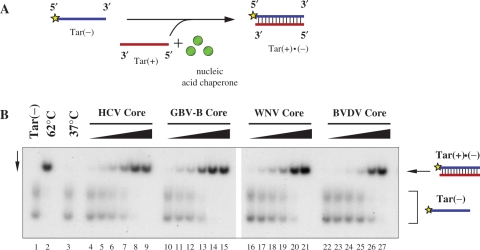Figure 2.
Flaviviridae core proteins exhibit DNA annealing activity. (A) Schematic representation of the DNA annealing assay. Radioactively labelled Tar(−) and the complementary Tar(+) ODNs are incubated in the absence or presence of the putative nucleic acid chaperone. Efficient hybridization of the oligonucleotides takes place only at elevated temperatures or in the presence of a protein with nucleic acid chaperone activity. (B) Annealing of complementary oligonucleotides is promoted by core proteins. 32P-labelled Tar(−) ODN was incubated together with Tar(+) ODN in the presence of increasing amounts of the proteins, as indicated at the top of the figure. Protein-to-nucleotide molar ratios were 1:160, 1:80, 1: 40, 1:20, 1:10 and 1:5 for each protein tested (corresponding to 1, 2, 4, 8, 16 and 32 nM protein concentrations, respectively). Lane 1: labelled Tar(−) ODN alone; lane 2: Tar(−)/Tar(+) complex formed by heat annealing at 62°C, without protein; lane 3: Tar(−)/Tar(+) complex formation at 37°C in the absence of protein; lanes 4–9, 10–15, 16–21 and 22–27: complex formation at 37°C in the presence of increasing concentrations of HCV, GBV-B, WNV and BVDV core proteins, respectively. Tar(−) migrates as two distinct bands due to its extensive secondary structures.

